Math Lessons
> Svogelsang
Zearn. Online Math Help, Tutoring & Problems. 10 Hands-On Strategies for Teaching Area and Perimeter. Every year, many of my students seem to have difficulty grasping the idea of perimeter and area.
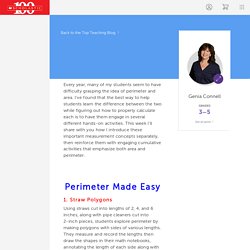
I’ve found that the best way to help students learn the difference between the two while figuring out how to properly calculate each is to have them engage in several different hands-on activities. This week I’ll share with you how I introduce these important measurement concepts separately, then reinforce them with engaging cumulative activities that emphasize both area and perimeter. Perimeter Made Easy 1. Straw Polygons. Finding Perimeter In this lesson, students will explore a real world problem based on the Marilyn Bu ...
Sorry!
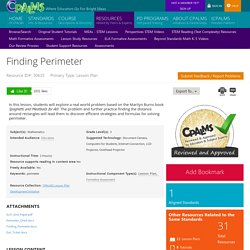
This resource requires special permission and only certain users have access to it at this time.
Super Teacher Worksheets - Thousands of Printable Activities. Discovering area and perimeter inquiry. Printable Lesson Plan On Area and Perimeter and Formulas. Spaghetti and meatballs for all lesson plan revised. Beacon Learning Center Lesson Plans. Description Students explore the relationship between the area of square units and their perimeters in a hands-on activity.
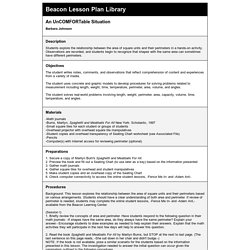
Observations are recorded, and students begin to recognize that shapes with the same area can sometimes have different perimeters. Objectives The student writes notes, comments, and observations that reflect comprehension of content and experiences from a variety of media.
Third grade Lesson Decomposing Given Large Areas, Day 3. The students have several different ways of approaching this task.
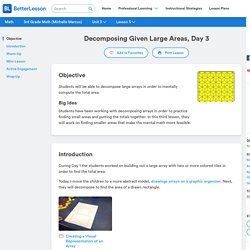
Some use rulers to measure and draw several smaller arrays, some work to find combinations of 5’s or 10’s, and some draw random lines and figure out the two array products to add together (MP4, MP5). This is fabulous! Although it may seem sloppy and unfocused with different outcomes for everyone, the comfortable struggle is very informative. As you read the above paragraph, you can probably already imagine how I might organize my students into strategy groups for tomorrow’s lesson! As students work, listen…I find the less I speak, the more I learn.
Third grade Lesson Decomposing Given Large Areas Day 2. My lesson is short today, as I know the students will need a lot of exploration and work time today.
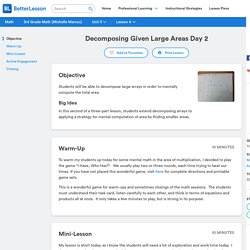
I don't want to give them too much of the "answer" or strategy, rather I want them to develop the best way for them to solve today's problems. As the students gather in our community area, I place a paper with 3 different rectangles on it in the center of our circle.
Third grade Lesson Decomposing Arrays, Day 1. Third grade Lesson Area and Perimeter in Real Life, Day 2. Today I am using the book Spaghetti and Meatballs for All with a different task in mind for my students.

We will discuss the fact that the area never changed for the Comforts. In other words, the amount of actual “space” taken up by the tables did not change. There were always 8 tables. However, the perimeter, or space around the edges for guests to sit, changed. Since the children explored this concept in the first lesson, I am now going to attach the correct terms to what they were doing and go a little deeper.
Yesterday Mathematicians, you explored ways to arrange the “tables” so that more people could sit down. As I read, I stop and allow students time to interact, and celebrate if they discovered their configurations matched those found in the book. Boys and girls, notice that there are never more tables brought into the room.
Third grade Lesson Area and Perimeter in Real Life Day 1. I display my book on the document camera so all students can take in the illustrations, which helps them connect to the math in this story.
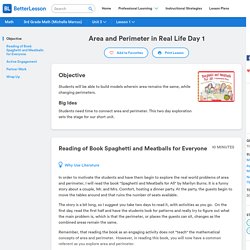
I think it is important to show the class the illustrations, as the story is read, so students pick up on that chairs are eliminated every time the same tables are rearranged. I found it helpful to pause at every page spread and have the students just observe the illustrations. They get a kick out of the antics of the cat! Use questions to guide them to see the visual clues that the perimeter (or seating space) is getting smaller.
Have them look for stacked chairs, people standing, Mrs.
PBLCCSSK2 0412w. Area of Rectangles: A More Efficient Way? In this lesson, students will connect the concepts of coun ...
Sorry!
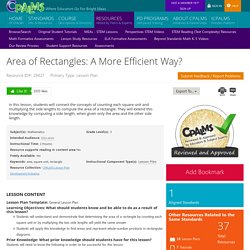
This resource requires special permission and only certain users have access to it at this time. Lesson Plan Template: General Lesson Plan Learning Objectives: What should students know and be able to do as a result of this lesson? Students will understand and demonstrate that determining the area of a rectangle by counting each square unit or by multiplying the two side lengths will yield the same answer.Students will apply this knowledge to find areas and represent whole-number products in rectangular diagrams. Prior Knowledge: What prior knowledge should students have for this lesson?
Students will need to know the following in order to be successful for this lesson:The area of a rectangle can be found by counting the square units.How to multiply one-digit by one-digit numbers.Vocabulary words: side length, area, square unit, unit, rectangle, square.
Additional Information/Instructions By Author/Submitter. Year 4 Mathematics Lesson Plans Archives. Area & Perimeter Unit Plan. Grade 6 Introduction | Concept Map | Timeline | Activities | Assessment | Unit Project Introduction: Area and perimeter are two important and fundamental parts of mathematics.
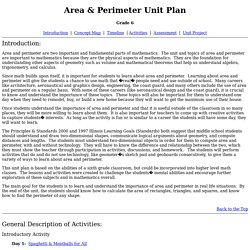
The unit and topics of area and perimeter are important to mathematics because they are the physical aspects of mathematics. They are the foundation for understanding other aspects of geometry such as volume and mathematical theorems that help us understand algebra, trigonometry, and calculus.
Jill V. Jill V.
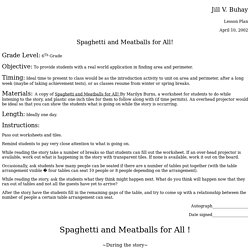
Buhay Lesson Plan April 10, 2002. Third grade Lesson Length x Width. I was noticing yesterday that many of you were counting the unit squares of figures to find the area. Did anyone come across all challenges when doing this? Yesterday I observed many students who lost count when determining the number of unit squares for area because - as the lesson intended - they were counting by ones. Today, I want to have a discussion around this to point out that we often need additional math problem solving tools in order to make problem solving more efficient. (BTW - If you need graph paper for this lesson, there are some terrific free downloadable resources online. One that provides a great deal of variety of grid types is Incompetec.)
Who can tell me what they know about the sides of a square? Students understand that rectangular arrays can be decomposed into identical rows or into identical columns.
Third grade Lesson Area Of Names. I use graph paper, a basic word - apple, to model how to create letters on the paper. I also draw the letters larger than single squares so that the area increases and challenges students into creating block letters rather than focusing on a single line.
Although this is not necessary, it provides some challenge to the students. Next, I focus on letters with slanted lines including k, m, n, v, w, x, y, and z. These letters will need to have special consideration depending on how the student draws the letters. These letters can individual boxes traced diagonally on the graph paper, or they can draw a straight line diagonally.
Third grade Lesson What is Area?
Finding Area. Third grade Lesson What is Area?
3.MD.5 - About the Math, Learning Targets, and Rigor: Grade 3 Mathematics. 3rd Grade Math - Unit 4: Area. Teaching Area and Perimeter - Ashleigh's Education Journey. EngageNY. All About Multiplication This four-lesson unit from NCTM's Illuminations has students explore severa ...
EngageNY. All About Multiplication This four-lesson unit from NCTM's Illuminations has students explore severa ...
Math / Units and Lesson Plans. Assessments, Homework, Lesson Plans, Videos, Games. Over a million resources aligned to Common Core, PARCC, SBAC. 3rd Grade Common Core Resources. 3rd Grade Math Curriculum - Common Core Lessons & Assessments. What’s 3rd Grade math all about? Grade 3 focuses on four key advancements from previous years: (1) developing understanding of and fluency with multiplication and division within 100; (2) developing understanding of fractions, especially unit fractions; (3) developing understanding of rectangular arrays and of area; and (4) describing and analyzing two-dimensional shapes.
How did we order the units?









